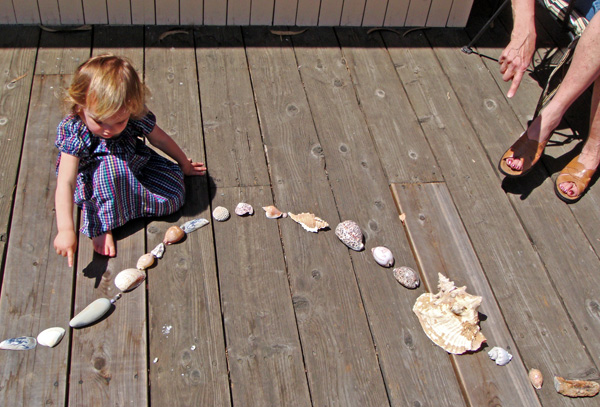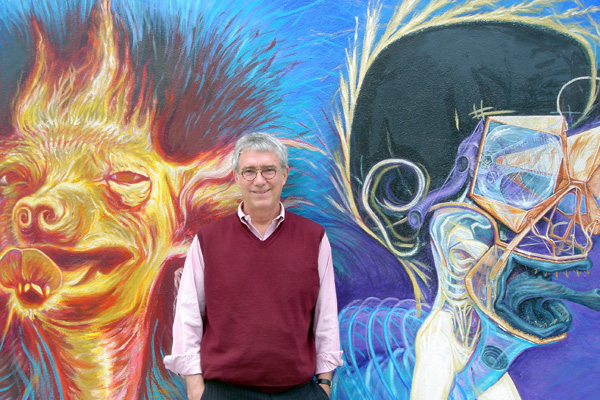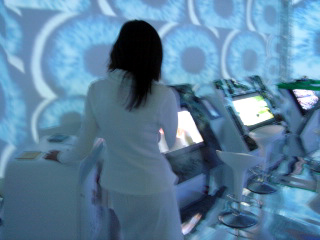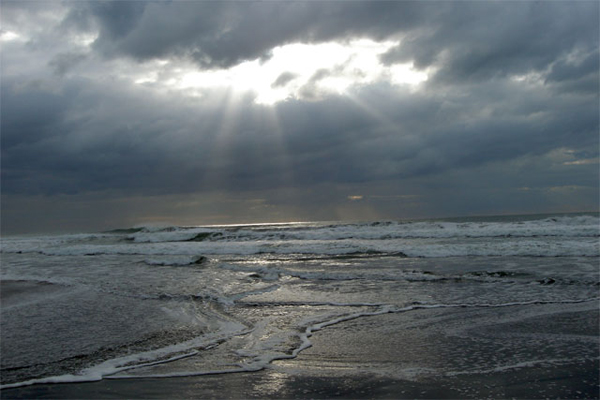
I started a new painting at Montgomery Hill park in East San Jose yesterday, next to Evergreen Valley Community College; the park is named after aviation pioneer John Montgomery who died when his glider, The Evergreen, crashed here in 1911. Sylvia suggests that I might add a painting of a UFO-type Flying Wing to a painting of this hill, like the one I wrote about in my novel, The Secret of Life. By the way the image above is an High Dynamic Range image fused from three exposures.
Word form your sponsor: “Jeez, not a single person has bought a notecard of my paintings at, ahem, rudy.imagekind.com, and they’re only $3.29 each (plus shipping). Whaddaya whaddaya.”

As regular readers of this blog know, I’m currently interested in a new cosmological model called the Cyclic Universe and have posted on it before. The theory has been popularized by the scientists Paul Steinhardt and Neil Turok in their very readable book, The Endless Universe. The basic idea is that our cosmos consists of two parallel sheets of space which are called branes.
Every so often (one guess is every trillion years), the branes slam together, which fills them with energy that can be in some sense gotten for free from the boundless riches of the gravitational field. This space-filling Big Splat replaces the point-like Big Bang. While the branes are apart, they expand, with the galaxies moving apart over the years. And eventually they embrace once again. It could be that there are an endless number of cycles in the past and in the future, and that the spaces involved are infinite.

The theory of the Cyclic Universe is controversial and some well-entrenched phycisists such Stanford’s Andrei Linde (whom I interviewed for Wired , years ago) and his wife Renata Kallosh are fighting against the theory with what I would call excessive or even hysterical or persecutional zeal. You can (vaguely) follow the battle on the boffin-zone arXiv.org site (see this Wikipedia entry on arXiv to learn what arXiv is all about).
In my amateur outsider’s opinion, Steinhardt’s camp is right. LInde’s inflationary theory is falling apart. One of the nicest things favoring Steinhardt’s side is that the Cyclic Universe theory only requires for there to be one (two-braner) universe, whose parameters are what they are due to certain underlying mathematical reaons. The Lindean inflationary camp claims there are perhaps googolplex universes and the one we’re in just happens to have the particular values we observe. Hopefully some new measurements of the cosmic microwave background radiation can help resolve the dispute experimentally before too long.

In any case, I decided I might write some science fiction about the Cyclic Universe, and I sent Paul Steinhardt a few questions about the theory via email. He answered them and kindly offered to talk on the phone so that I could ask some follow-up questions. The following is a distillation of the email and phone conversations. As it’s been edited by me, any errors should be ascribed to Rudy rather than to Paul.
(R1) It would be cool if a story’s main character finds out that the Big Splat of the recolliding branes is going to be TOMORROW, rather than in a trillion years.
(P1) According to our current models, the soonest the next splat could really happen is in ten billion years. The reason is that it takes nearly ten billion years for the branes to move back together, and as soon as they start approaching each other we can notice subtle changes. So if the branes were on the road to colliding, we would have noticed by now.

(R2) What are the kinds of observational evidence that tell you the tenth-dimensionsal separation between branes is dwindling? As I understand it, our universe itself will continue to seem like it’s expanding, so how might we notice the impending splat?
(P2) You’ll like this: as the branes begin to move towards one another, nature’s fundamental “constants” begin to change— Newton’s gravitational constant, the fine-structure constant that controls the strength of electricity and magnetism, etc. And the rate of change picks up the closer the branes get. It would seem like the laws of physics are changing faster and faster.
In the earliest stages, the first thing we’d notice would be slight variations in the spectral lines between nearby atoms and distant (older) atoms. Later on, the changes would be more dramatic. We’d notice the positions of spectral lines in a single sample of matter changing over the course of a day.
Later on, atoms might get larger, but you’d have other effects mixed in as well. It would become in some sense hard to say what size anything is, as our definitions of size are ultimately based on the fundamental constants.

(R3) Presumably any humans would be destroyed at some point; our molecules would fall apart, and so on. And then, of course, you’d have the Big Flash. Might we have any hope of surviving to the next cycle?
(P3) We might draw on the fact that the collisions between the branes only occur in places where the universe is nearly empty — which is ALMOST everywhere. But where there are black holes, their gravitational field is strong enough that the collisions do not occur near them. It is as if the black hole pins the branes together in those places where they lie, and that means there are no collisions.
If an advanced civilization could figure out how to create/manipulate black holes so that they are surrounded by them but do not fall into them and if they could protect themselves from the intense radiation of the collision (about 10^10 times the temperature of the sun), they could survive into the next cycle. One problem here is that, because of all the stretching of space that occurs from cycle to cycle, surviving black holes are spread out to an enormous degree — so the chances are that, by the time the Splat approaches, there are no black holes within mankind’s observable horizon. So, even if a civilization managed to do this, they would not likely be anywhere we could see them.

(R4) I like that idea. Maybe a science-fictional civilization could manufacture black holes! Of course it would be tricky to surround our planet with them and not have the holes collapse together. Maybe they could be furiously orbiting in some chaotic dance.
On a slightly different topic, I’m intrigued by the notion of finding some way to perceive that space is infinite. But we’re to some extent limited by that big flash that happened 14 billion years ago. If the universe is spatially infinite, might there perhaps be SOME kind of signal that makes it through the haze of the Big Flash, reaching us from distances larger than the light horizon? I’m thinking, for instance, of gravitons that started on their way before the last Splat, or even from several Splats ago.
(P4) Yes and no. There would be gravitational waves produced just before the last bang that we could detect in the present universe. But the signal is very, very weak. And I suppose a civilization that existed just before the end could send that signal. But the bigger problem with the gravitational waves and photons from earlier cycles, is that their wavelengths will have been stretched by the expansion of space. The 14 billion light year diameter sphere that we see around us began as a region less than a meter across. A meter-long gravity wave from those times would now span the visible universe. There would be no way to construct an apparatus to detect it.

(R5) So there’s no way to pass information from one cycle to the next?
(P5) One very speculative idea is that you might store information inside a black hole. Although we think of the two branes as parallel with a tiny separation, in the neighborhood of a black hole, as I mentioned before, the two branes dimple out and touch each other, merging into a single brane. So there’s not going to be an big splat and radiation burst inside a black hole.
Of course the hard part about storing information inside a black hole is getting it back out. There’s an ongoing debate among physicists about whether information that goes into a black hole disappears for good, or whether it might be retrievable if the black hole spontaneously evaporates. Or perhaps if you scatter some object off of the black hole. In the scattering case, it may be that you need something like an encryption key to retrieve the information, that is, you have to in some sense know what the black hole has eaten so far.

(R6) In terms of a smooth motion, it seems like it would be nicer if the two branes could pass through each other, rather than splatting and rebounding. Is that a possibility?
(P6) Sure, I like to think of it that way myself, as then you feel less worried about the branes getting stuck together. Whether we say they bounce or pass through each other is really just a matter of how we set up our coordinate system.
(R7) Might there be life on the other brane?
(P7) We think of the other brane as probably not being something like a mirror of our world, so it would be a very different kind of place. One might not have atoms or particles there in the usual sense.










May 15th, 2008 at 1:00 pm
dear rudy yu gnosis the damns on the surface of Ganymede – i think i remember – and may yu be safe – Zappastuff 2 y’all – i hope the elephants are well in Borma
July 27th, 2008 at 6:55 pm
Thank you for posting this engrossing and stimulating interview. I am just learning about branes, and find the imaginative questions and answers refreshing to think about.
September 8th, 2008 at 8:38 pm
Shimmerring branes in my poor old tired neural heap.
Riffs:
This IS the Big Bang. Now. It didn’t “happen”. It IS what’s happening.
Since the Big Splat is the “cause” of the present, may it not in some sense said to BE the present? Past and future created from Now, spiraling off into chains of algorithms fuzzing themselves into the nose-floor muck of two Heisenbergian horizons, beyond which any sensible theory must pass over in silence. Time past and Time future not so much empirically real as … stipulated … from an eternal now.
On now: Patti Smith – Ain’t It Strange
July 9th, 2009 at 1:40 am
Maybe my theory could explain why the constant was once much larger, but that its value decayed with each incarnation of the universe.
“The universe rejuvenates itself like a cell in the human body or a new brick replacing an old brick in a building. A universe dependent on an anti digital copying mechanism located in the density of a vacuum?
The human being also replaces its digital self every ten years or so and after the fourth time we lose the ability to copy our self exactly, hence “old age” The resolution of the universes digital self is also lowered until it can no longer copy itself. While the universe is accelerating and expanding the inner core of the constant anti matter is decomposing and shrinking. allowing lighter layers of dark energy to rise and escape through “plugs” throughout the universe of course these plugs are “Dead Stars” stars not only sit on the fabric of the universe but are stretched through layers of vacuums supplying energy to young dark matter that eventually becomes to heavy and descends to the constant.
When a star burns out it is half imbedded between the fabric of space and space, when collapsing into itself it fuses itself to the layers beneath the fabric so it can not be lifted up by the fabric. Like the navel does after the umbilical cord is detached.
Maybe it’s true that we exist now because the universe is weaker but it can also mean that were we to discover within our human race how to copy ourselves again in high resolution then maybe we can be that tiny speck that causes an anti bang.
March 20th, 2011 at 5:54 am
We could also look at this same concept from an ideal perspective. If you can swallow the idea of a universe made of mind, or awareness, rather than matter, these two clashing branes could be viewed as perpendicular ideas. This is what we usually refer to as a paradox. Two ideas, each acceptable from their respective vantage points, and yet contradictory of each other, could produce an entire universe if fueled by a sufficiently fiery stream of consciousness. This is, of course, an ancient idea (yin/yang, acid/alkaline, binary code, etc.), but it is interesting to compare it with the “big splat”. As for the appeal to an idealistic perspective, suffice to say that consciousness is still unaccounted for – no reductive explanation accounts for subjective experience. Hence, it is a mystery, and we are justified in viewing it as primary.
May 24th, 2011 at 4:16 pm
The spats between the two branes would create new heat/radiation energy but i fail to see how more matter can be produced. Also if the to branes cannot meet where there is a black hole. Then will it have little affect on galaxies because usally a black hole is in middle of them.
I have another point to make if there is a limit to the universe and it has a reflective skin. Some of extreme distance galaxies could even be our own milkyway when it was younger. On the whole i do like string theory/ cyclic universe but it may need refining in the years to come.
December 7th, 2011 at 9:19 am
I do not understand why the m-brane theory, the big bang would be the point of contact of two flat membranes.
Instead of having so many universes going to infinite, it would seem easier to consider the brane flat and tending to infinity, have only two concentric sfrere that attract and repel each other with a cyclic of Migliardi years.
and when they collide togheter gravity and dark energy reverse their sign atrction to repulsion.
While on a brane we have the matter or antimatter, in the other the matter is converted into energy with other physical laws.
As for the blacks holes that create a singularity are points of contact between the two branes where matter is asorbed and converted into energy and inverse in the field of energy.
It might work or is one of the many theories socks?
December 7th, 2011 at 3:48 pm
Thanks for the comments.
Edes Catto Het, The idea in this theory is that the big bang is not at a point. It is rather something that fill the entire sheets of the two spaces when they pass through each other.
And in this theory we only have two sheets of spacetime, not infinitely many. But we do have potentially infinite space in each universe, and a potentially infinite amount of time in which the cycles reiterate.
I wrote a story about this kind of universe with Bruce Sterling, it was in Asimov’s SF magazine, Feb, 2009, you can read the start of it here: http://www.asimovs.com/_issue_0902/collidingbranes.shtml, and eventually it will be in story collections by Bruce and by me.
April 11th, 2012 at 6:28 am
Is there a possibility within your theory that the branes are not completely separate but could be connected through a “string” in some places? Could these “strings” possibly connecting the parallel universes explain things like black holes, and/or places like the Bermuda Triangle and Zona de Silencia?